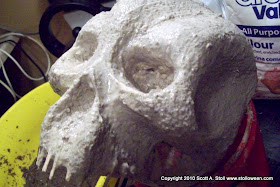
Assortment of papier mache props circa 2006 waiting to be sprayed with weather proofing sealant.

My beautiful and tolerant wife prepping for our first trip to GLFF (Great Lakes FrightFest) in May of 2007.
A few months ago I was asked for some more information regarding the way that I created the papier mache pirate skulls. The post over at www.stolloween.com only discusses the reason why I made 15 pirate skulls and does not go into any detail as far as the actual construction.
.JPG)
.JPG)
The pirates were made as an experiment for me to gauge how quickly I could create a certain number of props. The skulls also allowed me to evaluate my workspace and organizational requirements. During the construction process I was more concerned with creating vs. documenting so there are only a few photos showing the works in progress.
Based on the few photos I do have I can share the following information.
The eye patches were made from a piece of recycled cardboard coated with fabric and monster mud.
Earrings were created with utility wire then covered with papier mache clay, the chain was also made by sculpting papier mache clay.
Accessories such as knives or daggers were created with corrugated cardboard, strip mache and monster mud.
Bandanas were made from fabric coated with monster mud.
The eyeballs were simply papier mache clay molded in the bottom half of a plastic Easter egg shell.
Adornments on the hats were cut from craft foam and glued directly onto the papier mache hats and eye patches.
Twine and yarn were utilized for hair.
.JPG)
.JPG)
.JPG)
.JPG)
.JPG)
.JPG)
The whole construction process was basically a lesson of using whatever works. The pirate skulls are very much multi-medium pieces incorporating papier mache, clays, monster mud, fabric, twines, foam and cardboard. If you’ve got it, then use it!
.JPG)
.JPG)
.JPG)
.JPG)
.JPG)
.JPG)
.JPG)
.JPG)
.JPG)
.JPG)
Making your own paper pulp is a fun and rewarding experience but it also time consuming and somewhat messy which is why I now use the cellulose insulation for all of my clay needs. Another option is to buy commercially available products available at craft, hobby and art supply stores.
Tonight I had the chance to experiment with another paper source that could be used to make paper clay, the source is cat litter or more specifically Purina Yesterday’s News natural cat litter made from recycled paper products and is 99.7% dust free. The dust free aspect is a positive because cellulose fiber insulation generates quite a bit of dust when making into clay. Purina Yesterday’s News natural cat litter comes in a 15lb bag and cost me $6.99, it is available at major pet stores and many large grocery stores.
The product comes in the form of paper pellets and the following are the steps I took to turn the pellets into a paper clay useable for your papier mache projects.

.jpg)
The pellets were soaked in water for several minutes to soften.
.jpg)
The soft paper pellets where then shredded with a hand blender.
.jpg)
.jpg)
The water was then removed from the pulp by placing the mixture onto a piece of cotton fabric (old t-shirt) and wringing out the water.
.jpg)
.jpg)
.jpg)
The shredded paper pellets were then mixed with papier mache paste (flour + glue + drywall joint compound) and blended until achieving a firm, moldable clay.
.jpg)
.jpg)
.jpg)
The “Kitty Clay” mixture was then used on several experimental props including a shark and human skull. My first impression is that the clay is very useable although it is a slight bit “grainy” compared to other paper clays I have used. This clay accepts texture and smoothed out quite nicely by using a paint brush coated with papier mache paste.
The pieces will need to dry completely until I can say 100% that this technique works but right now I can’t think of any reason as to why there would be any problems.
.jpg)
.jpg)
.jpg)
.jpg)
.jpg)
A few weeks ago the family and I headed to
The works speak for themselves so just sit back and enjoy, you can also check out more of the festival here.
.jpg)
.jpg)
.jpg)
.jpg)
.jpg)
.jpg)
.jpg)
.jpg)
.jpg)
.jpg)